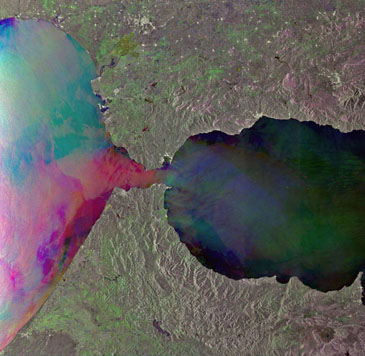Scores of ships pass through the Strait of Gibraltar every day -- cargo ships carrying oil and citrus fruits; cruise ships carrying thousands of passengers; and military vessels that patrol Mediterranean waters.
 The Strait of Gibraltar, which lies between the southern coast of Spain and the northern coast of Morocco, is the only place where water from the Atlantic Ocean mixes with water from the Mediterranean Sea. Credit: European Space Agency
The Strait of Gibraltar, which lies between the southern coast of Spain and the northern coast of Morocco, is the only place where water from the Atlantic Ocean mixes with water from the Mediterranean Sea. Credit: European Space AgencyBut a much bigger exchange is taking place below them. Water is flowing in from the Atlantic Ocean at the surface, and out from the Mediterranean Sea at the bottom. But a lot more is coming in than going out.
Except for the Strait of Gibraltar, the Mediterranean is pretty much landlocked. And during most of the year, warm, dry winds blow across its surface, causing a high rate of evaporation. In fact, the Mediterranean loses close to three feet of water from its surface every year.
To make up the deficit, water pours in from the Atlantic through the Strait of Gibraltar. This water is relatively warm and not as salty as that in the Mediterranean. As it flows eastward, though, some of the water evaporates, so it gets saltier and denser, making it sink. And as it sinks it gets colder, which makes it even denser.
This process helps set up a circulation pattern throughout the Mediterranean basin. At the bottom, some of the currents flow back toward the Strait of Gibraltar. When they get there, they’re forced up and over a shallow sill and out into the Atlantic.
Because of the Mediterranean’s high rate of evaporation, though, there’s not an even exchange of water going in and out. About six percent more comes in from the Atlantic -- an extra 500 cubic miles every year.

